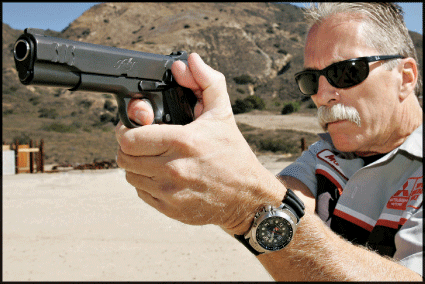For those readers coming in late, Kimber once again responded to a specialized LE unit’s request for a uniquely configured Kimber 1911. The Los Angeles (CA) Police Department’s Special Investigations Section (SIS) wanted a 1911 pistol chambered for the .45ACP round; they wanted four of them for duty and concealed carry while performing their innocuous-sounding duties, the surveillance of known criminals.
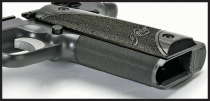 SIS wanted a full-size, 5-inch-barrel pistol with and without light rail, a 4-inch barrel on a non-rail, full-size frame, along with a more compact 3-inch barrel on a shortened-frame gun. All were to have a commonality of features as far as possible. SIS looked to Kimber based in large part on LAPD SWAT’s successful adoption of Kimber pistols in 2002.
SIS wanted a full-size, 5-inch-barrel pistol with and without light rail, a 4-inch barrel on a non-rail, full-size frame, along with a more compact 3-inch barrel on a shortened-frame gun. All were to have a commonality of features as far as possible. SIS looked to Kimber based in large part on LAPD SWAT’s successful adoption of Kimber pistols in 2002.
Advertisement — Continue Reading Below
Well, this is correct as far as it goes, but what’s been left out is that these surveillances are predicated on reliable information obtained from other detective divisions, which identify high-risk violent offenders thought to be preparing to commit yet another potentially violent crime. SIS is charged with observing these preparations and then catching the offenders in the act. In other words, SIS can expect to find themselves in an armed confrontation when their surveillances pay off.
SIS officers, of course, do not take handguns to gunfights as they are well armed with short-barreled 12 gauge pump-action shotguns and 5.56mm NATO-chambered M4 carbines. Handguns are there for when things don’t go as anticipated or planned; for instance, when the suspects act precipitously without any indicators. Or, worst-case scenario, the suspects decide to counterstrike against the watchers. (An exaggerated example to be sure, but the 1995 movie Heat, starring Robert De Niro and Al Pacino, depicts such activities.)
Check out the Top 5 Hollywood Action Movie Criminal Shootouts
Advertisement — Continue Reading Below
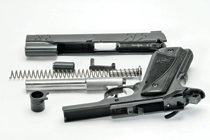 Gun Details
Gun Details
Well, knowing what SIS wanted, let’s look at what they got. The sample examined here is the SIS Custom, a full-sized Kimber 1911 without a light rail on its dust cover; the workhorse of the group, if you will. (The other three guns Kimber provided are the SIS Custom RL, full-size with light rail; the SIS Pro, full-length frame with 4-inch barrel; and the SIS Ultra, with 3-inch barrel and shortened frame.)
Multiple features are quickly noted during the most minimal examination of the SIS Custom. Taking the gun in hand, you immediately feel the fine frontstrap checkering of 30-lines-per-inch (lpi), and the all-steel 8-round Kimber magazine aggressively ejects when the magazine catch (with checkered head) is firmly depressed against its full-power magazine catch spring.
When I first worked the slide at King Shooters Supply, I stopped and reworked it again, this time paying attention to details. The grasping grooves are cleverly cut to form the initials “SIS.” This sample, as well as the others, is finished in Kimber’s proprietary KimPro II finish and, here, is colored dark gray. Thus, it’s the KimPro II finish that is responsible for felt slipperiness; for its composition, in addition to providing durability, includes a level of lubricity. This latter supplies additional smoothness and reliability to the parts so treated.
Advertisement — Continue Reading Below
A few more slide retractions confirmed my suspicion. The SIS Custom uses an 18-pound recoil spring rather than the 16-pound spring, which is standard for .45ACP full-sized 1911s. Later, I read where it was asserted the SIS chose Federal Tactical Bonded +P 230-grain JHP for duty use, which explains the heavier spring weight.
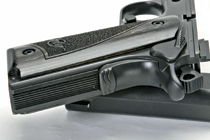 Next, I flicked the ambidextrous thumb safeties on and off, and they moved smoothly and positively. I then followed this by pressing the trigger, which weighed in at 5 pounds. Looking through the sights showed Meprolight night sight inserts, with both sights dovetailed in the slide on the top of the slide flattened between the two. The rear sight’s configuration is unique and labeled “SIS Night Sight.” The LAPD unit wanted a rear sight that lends itself to hooking it such that the slide can be manipulated one-handed. To aid this action, the SIS Sight has its front shoulder squared to the slide.
Next, I flicked the ambidextrous thumb safeties on and off, and they moved smoothly and positively. I then followed this by pressing the trigger, which weighed in at 5 pounds. Looking through the sights showed Meprolight night sight inserts, with both sights dovetailed in the slide on the top of the slide flattened between the two. The rear sight’s configuration is unique and labeled “SIS Night Sight.” The LAPD unit wanted a rear sight that lends itself to hooking it such that the slide can be manipulated one-handed. To aid this action, the SIS Sight has its front shoulder squared to the slide.
Further inspection showed the rounded, lightweight SIS hammer to be blackened and the beavertail and bumped grip safety disengaged nicely after being depressed about half way. The flat mainspring housing is grooved. The barrel is nicely ramped and the chamber hood is notched at its top rear, done to serve as a visual loaded-chamber indicator.
Advertisement — Continue Reading Below
The grip panels, held on by blackened hex-head screws, are a bit wider than standard and are both smooth and stippled, with stippling done to the laminated panels only where a shooter’s fingers grasp the panels. Much later, I also saw another benefit to the thicker grips. They push my shooting-hand knuckle further out from the gun such that the ambidextrous safety levers don’t bump it.
The magazine well is slightly beveled, enough to aid in magazine changes, but not so exaggerated as to hold dirt and debris as might get jammed in a more aggressively beveled well, which could happen if you wind up fighting from the ground. The supplied KimPro Tac-Mag magazine uses a McCormick follower and has a removable base plate with six cartridge witness holes on either side of its body. An additional base plate and two rubber base pads of different thicknesses are included.
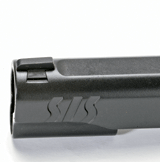 Shooting Impressions
Shooting Impressions
Range work was uneventful but satisfying, as is the norm with Kimber pistols. If I do my part, the gun shoots as well as I’m able to break the shot. Here, I shot it indoors at 20 yards, seated, using my Waller gun bag as a rest. The SIS pistol, with Black Hills 230-grain +P JHP, gave me a 1.25-inch five-shot group. This level of accuracy repeated itself with CorBon 230-grain Performance Match, Hornady 185-grain JHP and Winchester (white box) 230-grain JRN, with no group going outside 2 inches. There were no malfunctions.
Advertisement — Continue Reading Below
One other feature I failed to mention earlier. The SIS Custom pistol comes without a passive firing pin safety, the presence of which is solely due to believing that a properly constructed and maintained 1911 will fire if dropped unless its firing pin is so restrained. While this is indeed possible, if the pistol has a weak firing pin spring, an overly sensitive or high-cartridge primer and is dropped directly on its muzzle from 12 feet or higher against a hard surface. Without it, you now have one less part to malfunction and a better trigger pull. This sample is true to the first iteration of the SIS request, but I also understand the specifications were changed to a passive firing pin safety to be in compliance with California’s Department of Justice rule, which mandates all guns sold in California must have this sort of firing pin safety.
Final Notes
All of the preceding certainly demonstrates that LAPD’s SIS has an excellent pistol, but it’s fair to also ask if this setup is suitable and useful for those of us not tasked with apprehending some of the most violent criminals in our society. The short answer is yes, as the goals remain the same. Both want, and get, reliability, durability, accuracy and a well fitting 1911, certainly suitable for personal defense, competition or just casual shooting. The SIS looks good, too. The only downside with one is you can’t fault the gun for your misses!
To obtain one, Kimber suggests contacting a local Kimber Master Dealer. Also, you can visit the website at www.kimberamerica.com. You can also go there to view some excellent video footage of the SIS pistols in action.
Advertisement — Continue Reading Below
